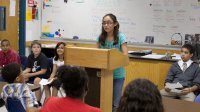Using the Election as a Teaching Tool
With careful planning, teachers can use the election to foster social and emotional learning and connect math, literacy, and social studies lessons.
Your content has been saved!
Go to My Saved Content.On November 9, 2016, I walked into my math and science classroom and met students who were experiencing a wide range of emotions regarding the outcome of the election. I opted to teach that day by not only analyzing votes and electoral data but also asking students to write about their understanding of the election. In doing so, I was able to teach the election through a cross-curricular lens and create a safe space to help students understand and process it.
I’ve reflected on how I taught past elections in my classroom, and now, as I work with teachers as a mentor, I’m encouraging them to not only use the election as a jumping-off point for content but develop lesson plans focused on their students' social and emotional needs around the outcome. That way, teachers are prepared to handle and even leverage the complexities that characterize this remarkable moment.
Creating a Safe Space for Discussion
As we approach Election Day, our role as educators is to empower our students to understand the inner workings of our democratic process and the historic moment we are living through. We need to create safe spaces to address the social and emotional needs of our students so they can focus on learning, while empowering them with the tools they need to think critically about the world around them.
One way to address students’ social and emotional needs is to use community circles to establish a classroom norm of talking, tolerance, and empathy. Effective community circles have clear, co-constructed norms and procedures that ensure that students can share their thoughts and opinions, and listen to and respect one another. Social justice standards from Teaching Tolerance provide a strong framework to help teachers build lessons centered on respect and empathy; that approach can help students learn how to respect others who have different viewpoints and how to express disagreements in a constructive manner. Another option is to develop discussion norms in collaboration with students.
Many teachers also find themselves wondering how to answer student questions, manage their discomfort discussing the election in a Zoom classroom, and address disagreements or polarizing political rhetoric from students. The Civically Engaged Classroom outlines a plethora of activities teachers can use to address these concerns. Other sites—like Rock the Vote, Facing History, iCivics, and the Center for Civic Education—provide nonpartisan resources around civic engagement and voting for educators. Nearpod has many curated lessons about the electoral process, voting, and government.
Cross-Curricular Approaches
It’s important that discussion about politics and the 2020 election not occur in silos or only in social science classes, but across content areas. A clear teaching plan, no matter what subject you teach, is key to creating a safe learning space for students.
Math: Political pundits suggest that we may not know the outcome of the election on election night. Use this opportunity, both before and after November 3, to track both the popular vote and electors in the Electoral College, and consider making use of FiveThirtyEight, a website that uses a wide array of polling and forecast data to project election outcomes (including in some local races) or the University of Virginia’s Center for Politics, which also offers data and analysis.
Consider teaching students how to apply mathematical concepts to the total votes earned by each candidate and analyze local election data on propositions and ballot measures. Alternatively, teachers can host a mock election using Zoom polls or Google Forms, analyze classroom votes, and compare them to actual election results.
Reading graphs and charts is key to understanding elections, and is a skill that can be utilized in many content areas. Demonstrate how to create line, graph, and pie charts. Students can then create their own graphics using election and polling data to make predictions or analyze outcomes. Examine election forecast models from different news outlets and ask for observations about what each one analyzes.
Reading and writing: Help students analyze media sources as part of media literacy. Students can evaluate multiple sources, look for objective evidence or biases, and discuss the power of persuasion as well as the perspectives offered by diverse news outlets.
In terms of writing, prompts like “Twenty years from now, I hope my future children will describe this country as...” or “One thing I wish adults who voted knew is...” allow students to share and process their understanding of the election and the democratic process. Students can also write persuasive essays centered on their beliefs and opinions, while simultaneously learning how to use evidence to back up their opinions.
Social studies: Discuss the role of the Electoral College and its purpose, dive into the Constitution, and examine the process by which power is transferred from one president to another. You could also analyze the evolution of voting rights over time, compare and contrast similar moments in history to our current election, or study the branches of government and their role in a presidential election.
Elections present a powerful learning opportunity for students. While it might be a challenge to teach around the 2020 election, when instruction is framed in an unbiased, respectful way, we can advance our students’ understanding of politics, history, and other academic subject matter, while supporting them socially and emotionally. Together, we can educate and empower our next generation of voters.
